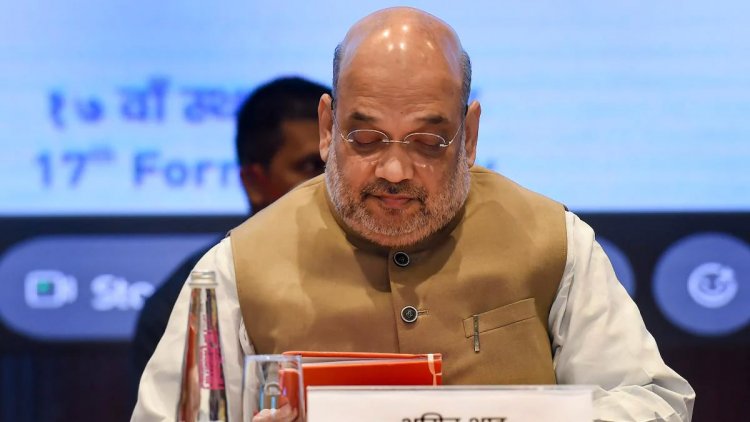Internal Security Challenges for Home Minister
Asia News Agency

On 13 November, a Colonel, his wife, their eight-year-old son, and four soldiers were killed in a terrorist attack on Assam Rifles’ convoy in Manipur near India-Myanmar border. Assam Rifles is under the administrative control of the ministry of Home Affairs. The incident is a wake up call for the Centre and has put pressure on the Union Home Minister Amit Shah to find a solution to the issues in the strategic Northeast region. Militancy is just one of them. The BJP has made serious inroads politically into the region. The internal security challenges will test Minister Shah.
Challenges in the northeast
As India’s home minister, writes D K Singh (editor politics, ThePrint) Amit Shah “is confronted with huge challenges, especially on the internal security front. Shah often talks about Prime Minister Narendra Modi’s vision for an ‘insurgency-free' Northeast. The latest terror attack in Manipur shows it’s not going to be so easy. It’s been a tightrope walk, anyway.”
The last time terrorists had targeted security forces’ convoy in Manipur was in 2015 when their attack had resulted in the death of 18 soldiers. Niki Sumi, military commander of the National Socialist Council of Nagaland (Khaplang), was the prime accused. In September 2021, however, the Modi government signed a ceasefire agreement with the Niki Sumi faction of the NSCN (K). Sumi had formed the faction in 2019.
In August 2015, the Centre’s interlocutor R.N. Ravi had signed a framework agreement with NSCN (I-M) in the presence of the Prime Minister. Over six years later, a final accord still eludes even as the interlocutor has been changed.
Boundary disputes between north-eastern states add to the complexities in the region, says Singh. Last July, the killing of six Assamese police personnel by the Mizoram police had created tensions between the two states, leaving the Centre in a bind.
Challenges in J&K and of CAA
Others that the Northeast, there are challenges in Jammu and Kashmir after the revoking the special status of Jammu and Kashmir (Article 370) and bifurcating the state into Union Territories. Shah then got parliamentary approval for the Citizenship Amendment Bill and even declared his intent to roll out the National Register of Citizens (NRC) across the country.
From early 2020, however, writes Singh “the ride has been rough, beginning with northeast Delhi riots during then-US President Donald Trump’s visit to India. The CAA remains only on paper two years after parliamentary approval because the home ministry has been unable to frame rules. Even in Kashmir, terrorist attacks on civilians, especially Pandits, have dashed hopes of a return to normalcy soon….”
The Naxalism challenge: Gadchiroli encounter
Former Prime Minister Manmohan Singh once said Naxalism is India’s most serious internal security challenge. Although Naxalism survives in fewer pockets, they still remain a serious internal security threat.
Two weeks ago, Naxalites, also known as the proscribed Communist Party of India (Maoist), lost 26 personnel in a police operation in Gadchiroli.
Gadchiroli, a largely forested and tribal-dominated district, remains one of the few districts “severely affected” by left-wing extremism. It is among Maharashtra’s poorest and the Maoists have sought to expand their presence extending from neighbouring Chhattisgarh. There have been major encounters in the district, with recent ones involving the deaths of 40 Maoists in two separate operations in April 2018 and a landmine blast claiming 15 police personnel in May 2019.
The Maoists’ inability, not just to expand but also to entrench themselves, writes The Hindu “is to some extent to the credit of the Indian state apparatus, both its security establishment and its work, through development schemes, in weaning away support for the Maoists among the poorest and marginalised sections, especially in remote areas. At the same time, this is also a reflection of the incongruence of the Indian Maoists’ programme which bases itself on replicating the Chinese Revolution of the previous century, and its quixotic pursuit of armed struggle as the means to achieve its aims. Neither are the conditions in India remotely closer to that of China in the 1920s, nor are the peasantry — whose support the Maoists deem as crucial to their project — enamoured of the Maoist programme or its reliance on guerilla struggle. The Maoists’ refusal to acknowledge the diverse industrial base in the country, their rejection of liberal democratic instruments in the Indian state and the faith of the poor in the robust electoral system have blinded them to pursue a futile cause…..”
Part of the credit goes to Shah, but he has hiss work out out in the Mosist belt.
The UP election challenge
Then there is politics which is not internal security, but has bearing on Amit Shah’s credibility. The battle for assembly election in 2021 has started in right earnest. The most crucial contest is in Uttar Pradesh. BJP is over dependent on Shah for the assembly elections scheduled later next year in Uttar Pradesh. “He has been the architect of the BJP’s political domination in UP since 2014. Yogi Adityanath, if he gets a renewed mandate in 2022, may hope to emerge as a Prime Ministerial candidate some time in future, but the credit must go to Shah if the BJP does it again in UP……”
Need for Nadda to step in: In the circumstance when Shah is over worked, Singh suggests “BJP national president Jagat Prakash Nadda needs to step up. He was elected to this post in January 2020….” But he “still remains Shah’s understudy, almost two years after succeeding him. Given the challenges on the internal security front, it’s probably time the Union Home Minister stepped back a little and focussed more on governance. One never knows Nadda may spring a surprise.”















